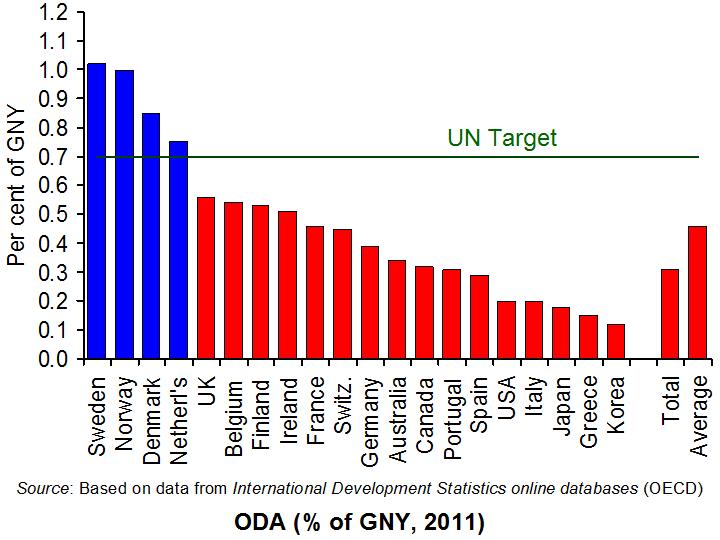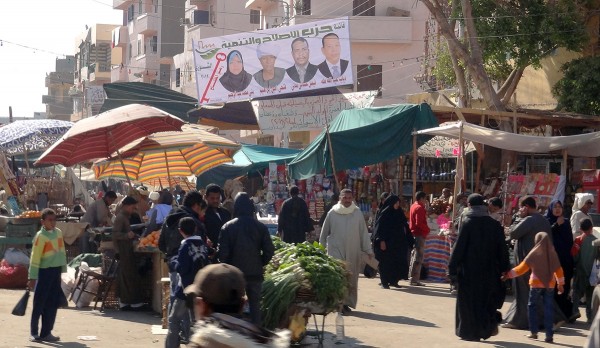How much does aid aid development?
 Many rich countries have made repeated commitments to the United Nations to give at least 0.7% of their gross national income (GNY) as international aid – or ‘official development assistance (ODA)’ as it is known. The first such commitments were made in 1970. Despite this, many of these countries’ aid to developing countries falls well short of the target.
Many rich countries have made repeated commitments to the United Nations to give at least 0.7% of their gross national income (GNY) as international aid – or ‘official development assistance (ODA)’ as it is known. The first such commitments were made in 1970. Despite this, many of these countries’ aid to developing countries falls well short of the target.
In fact the average amount given in aid in 2011 by the 23 donor countries which are members of the OECD’s Development Assistance Committee (DAC) was a mere 0.31% of GNY, with the USA, the biggest donor in absolute terms, giving only 0.2% of GNY. (Click here for a PowerPoint of the chart.) Since 2003, the DAC average has been 0.29% as compared with 0.30% between 1970 and 2002.
 In 2005, at the Gleneagles G8 summit, the 15 members of the EU which are Development Assistance Committee members committed themselves to reaching an ODA target of 0.51% of GNY in 2010 and to reach the 0.7% target by 2015. In 2011, the UK’s ODA/GNY ratio stood at 0.56% and so was above the EU target.
In 2005, at the Gleneagles G8 summit, the 15 members of the EU which are Development Assistance Committee members committed themselves to reaching an ODA target of 0.51% of GNY in 2010 and to reach the 0.7% target by 2015. In 2011, the UK’s ODA/GNY ratio stood at 0.56% and so was above the EU target.
Section 18 of the Coalition agreement pledges that the UK government will meet the 0.7% target by 2013 – a pledge initially made by the Labour government. So far, the government has stuck to this pledge and the aid budget has escaped cuts.
But with other parts of government expenditure facing cuts, pressure is mounting on the government to reduce the aid budget. There are two main parts to the argument. The first is that aid should face its ‘fair share’ of the cuts. The second is that aid is often an inefficient way of tackling poverty in developing countries and, when discussing aid, the focus should be on getting value for money rather than on the simple total amount of aid.
The following articles look at arguments for and against meeting aid targets and examine ways of making aid ‘smarter’.
Articles
Money may be tight, but ‘smart aid’ to developing countries can really work The Guardian, Larry Elliott (13/1/13)
International aid, but not as we know it The Guardian, Andy Sumner and Richard Mallett (31/12/12)
One in four support Britain’s foreign aid policies The Telegraph, Ben Leach (29/12/12)
Why is so much UK aid money still going to companies based in Britain? The Guardian, Claire Provost and Nicola Hughes (21/9/12)
Is the 0.7% aid target still relevant? The Guardian, Niels Keijzer (2/8/12)
What’s wrong with foreign aid? The Spectator (3/1/13)
Five reasons to deliver and legislate on international aid bond, UKAN (6/12)
The Political Economy of Bilateral Foreign Aid Working Knowledge, Harvard Business School, Eric D. Werker (4/1/13)
Misconceptions about aid Dawn (Pakistan), Niaz Murtaza (8/1/13)
Why political short-sightedness and randomised control trials can be a deadly mix for aid effectiveness Vox EU, Anders Olofsgård (13/10/12)
Aid in troubled times DfID, Paul Collier (2/7/12)
Data and information
Aid Effectiveness data World Bank
Aid statistics OECD
Aid effectiveness OECD
Aid Wikipedia
Questions
- What was agreed at the Gleneagles G8 summit?
- Examine the argument that aid crowds out private investment.
- Compare the relative benefits of tied and untied aid.
- Give some examples of ‘smart aid’.
- How would you establish whether or not it is ‘fair’ to cut the aid budget?
- Give three arguments for maintaining the aid budget and three arguments for cutting it. On which side do you come down and why?